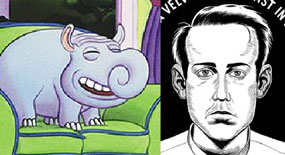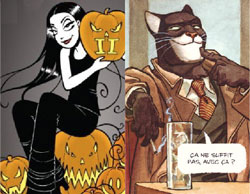 Jim Woodring doing kids’ books!? That was apparently the thought behind Trosper, a 2001 release from Woodring that came with a Southwest Asia-influenced music CD by Bill Frisell. A baby elephant-like creature runs from things that go bump in the night. Maurice Sendak would be proud.
Jim Woodring doing kids’ books!? That was apparently the thought behind Trosper, a 2001 release from Woodring that came with a Southwest Asia-influenced music CD by Bill Frisell. A baby elephant-like creature runs from things that go bump in the night. Maurice Sendak would be proud.
Going further back, Daniel Clowes’ early ’90s comedy/nightmare graphic novel Like a Velvet Glove Cast in Iron also has a musical soundtrack (sold separately), from Victor Banana. The book is a lesson in controlled chaos; the CD, a commentary on it. Tim and Kevin explore the audible and visual aspects of both these comics.
PLUS: Ritz Crackers! Jimmy Durante! The Brady Bunch! This one has it ALL! (including spoilers!)
Podcast: Play in new window | Download







 A maligned magician steps up in a time of crisis to become a hero! Tim and Mulele discuss Jason Love’s
A maligned magician steps up in a time of crisis to become a hero! Tim and Mulele discuss Jason Love’s  Electronic publishing has made it possible for anyone, anywhere in the world, to make their work available to millions of people. Chinese graphic designer and sometime comic creator Liu Jing is one of them. He’s using modern technology to put out his comics history of one of the world’s oldest civilizations:
Electronic publishing has made it possible for anyone, anywhere in the world, to make their work available to millions of people. Chinese graphic designer and sometime comic creator Liu Jing is one of them. He’s using modern technology to put out his comics history of one of the world’s oldest civilizations: 